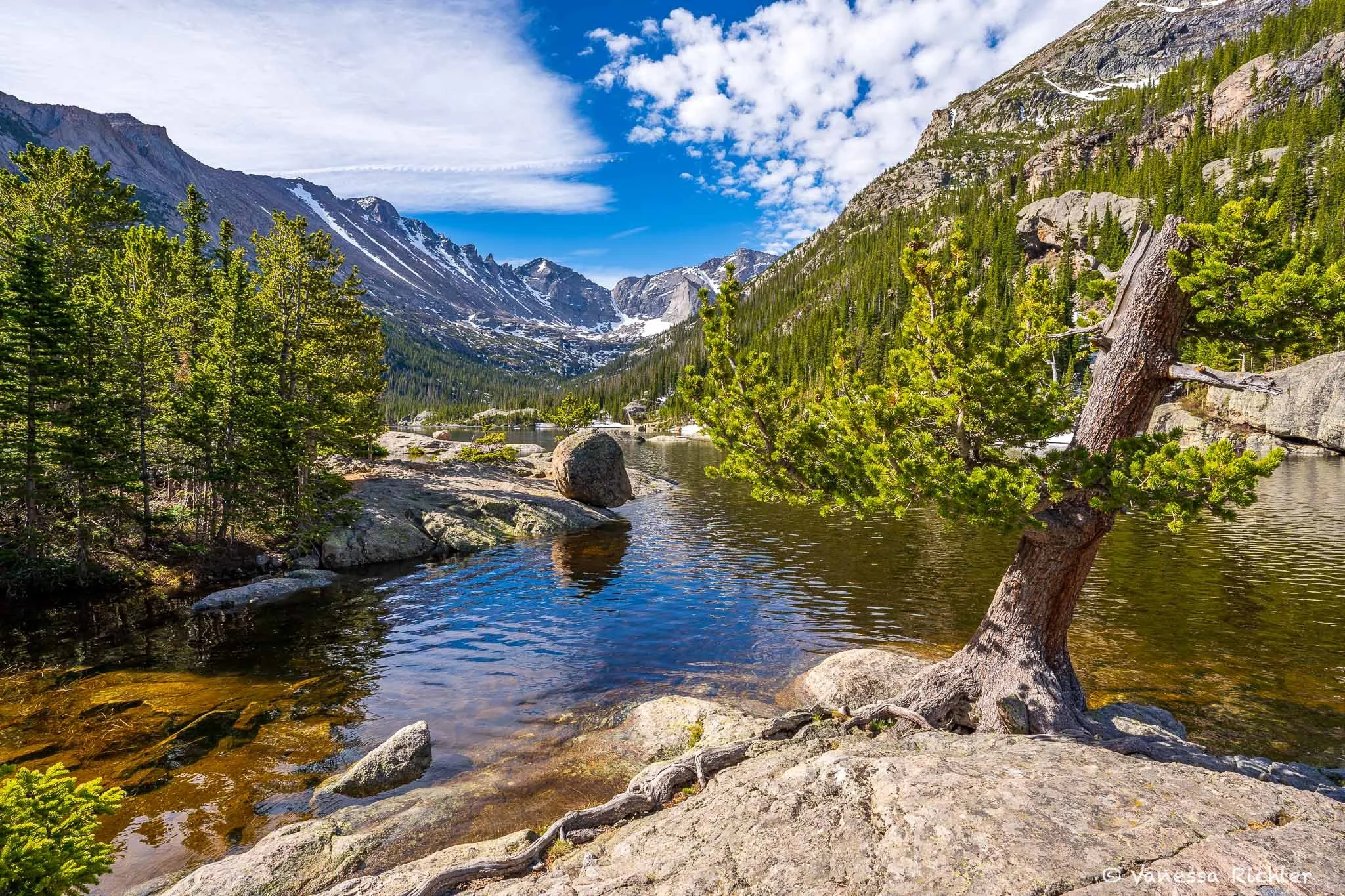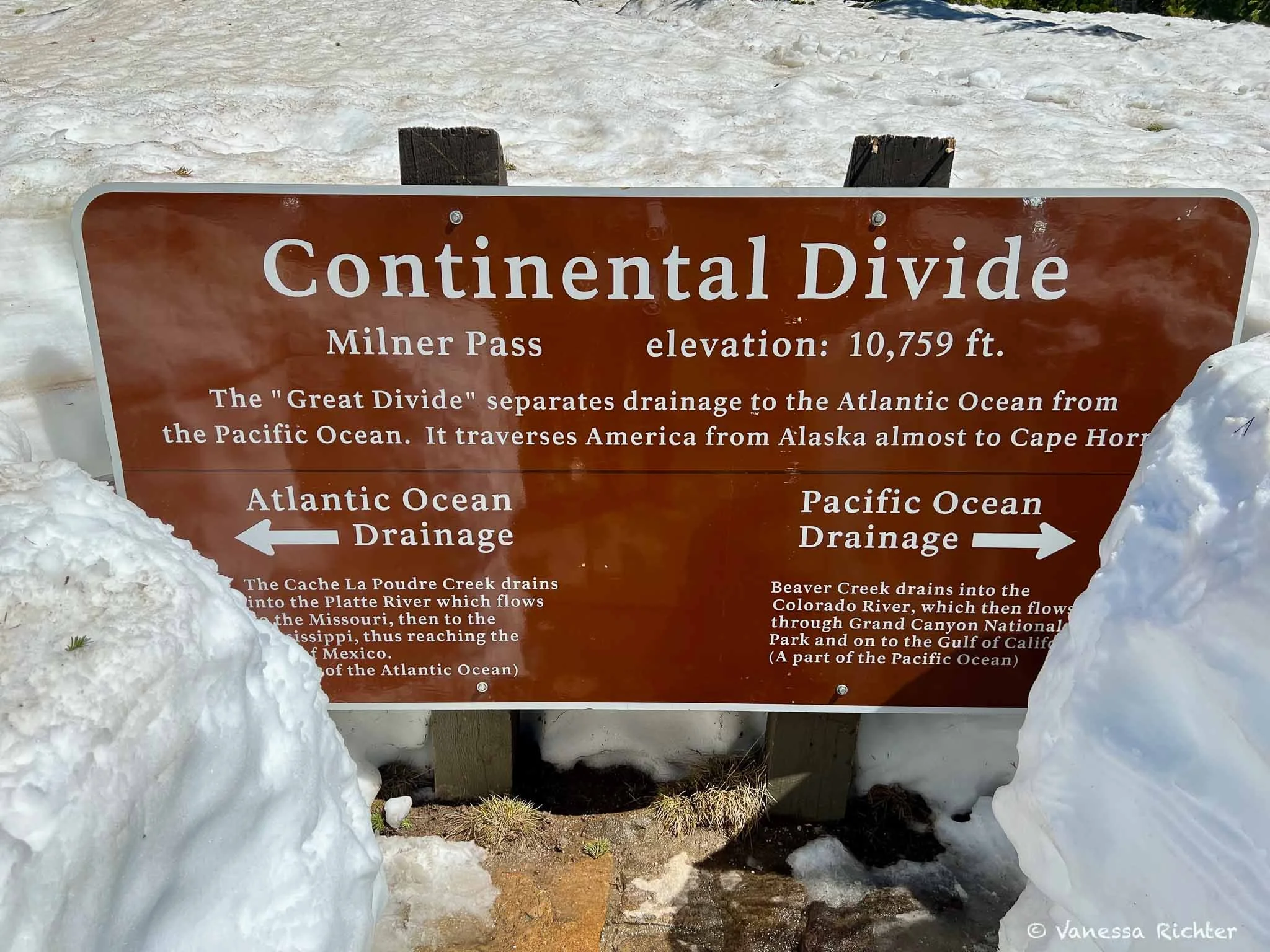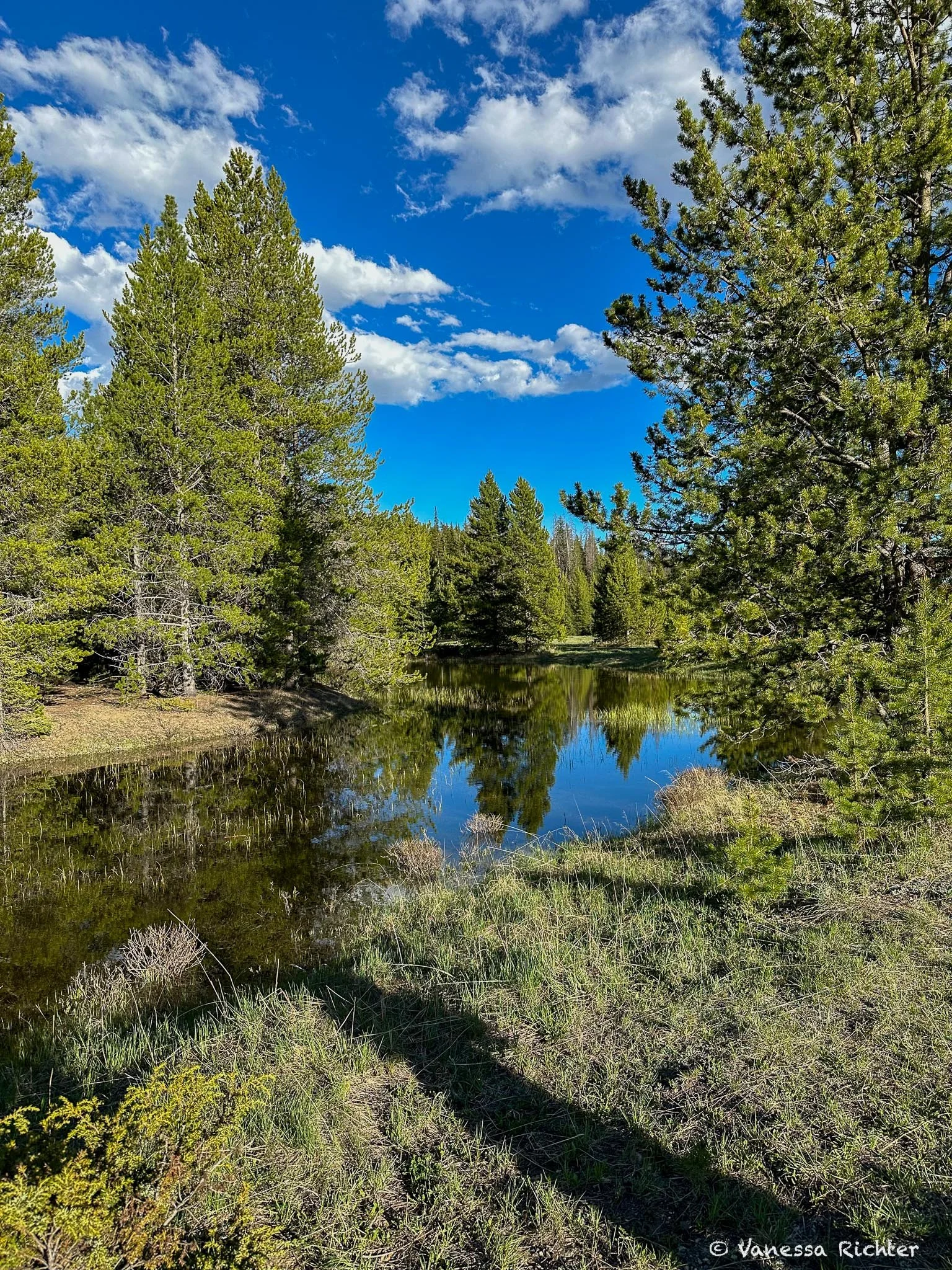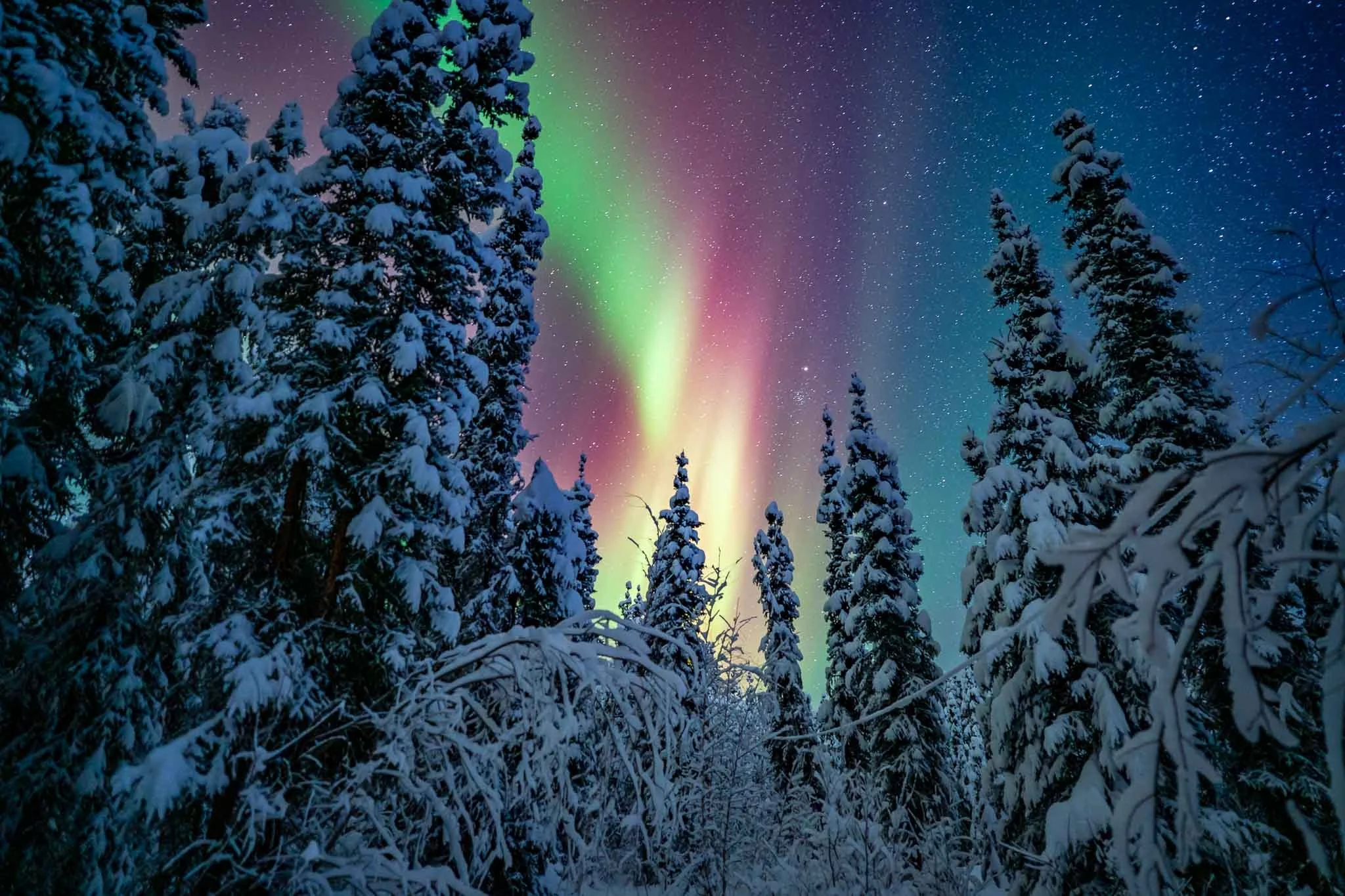How to Spend 1-2 Days in Rocky Mountain National Park (Late Spring Edition)
Rocky Mountain National Park is a place where rugged peaks, alpine lakes, and endless skies meet. Whether you’re hiking to a glacier-fed lake, trying to spot moose, elk, or marmots, or just soaking in the crisp mountain air, Rocky Mountain National Park is a dream for outdoor lovers. And with Trail Ridge Road—one of the most scenic drives in the United States—there’s no shortage of jaw-dropping views.
In this guide, I’ll share my recommendations for how to spend a short visit to Rocky Mountain National Park, tailored to a visit in late spring or early summer. This itinerary is perfect if you want to experience a little bit of everything that makes this park so special—spotting wildlife, hiking scenic trails, exploring alpine lakes, and driving along mountain roads. We had 1.5 days for this itinerary (starting early afternoon on the first day and continuing early the next morning), but you could also compress the activities into a single day or stretch it to two if you prefer a more laid-back pace.
In a Nutshell: Is this Guide Right for You?
- You’re planning a visit, particularly in late spring or early summer (note: works for summer overall & fall too—see below for more!)
- You have around 1–2 days to explore the park (or you have longer and are looking for a great introduction)
- You want a bit of everything: wildlife viewing, hikes, alpine lakes, and scenic drives
- You’re deciding between a relaxed pace or a more activity-packed itinerary
As mentioned above, all of these activities are also possible in summer and fall, so feel free to follow this guide even if you're visiting later in the season. The reason it's tailored to late spring is because Trail Ridge Road typically reopens around Memorial Day weekend, after being closed all winter due to snow. At this time of year, many higher elevation trails are still buried in snow, and some alpine lakes may remain partially frozen, while lower elevation areas are starting to open up. Consequently, if you’re visiting during the high season of summer or in early fall, you’ll likely have access to a wider range of hikes, as snow continues to melt. Just note that this guide doesn't apply to winter, when Trail Ridge Road is closed, many trails are snowbound, and some higher elevation routes may be at risk of avalanches or only accessible with snowshoes or skis.
If that all sounds good to you, settle in, grab a cup of coffee, tea, or whatever you need to get cozy, and let’s get started!
Table of Contents
Trail Ridge Road
Kawuneeche Valley
Second Day (Bear Lake Corridor)
Alpine Lakes Hike: Mills Lake & The Loch
Bear Lake
Just so you know: This post contains affiliate links, which means I may earn a small commission if you make a purchase through them — at no extra cost to you. I only recommend tours, gear, or services I truly believe in and think you’ll love too. Thanks so much for supporting my blog!
First (Half) Day
Trail Ridge Road
Starting off with this scenic drive will give you the opportunity to get a good overview of the parks range of ecosystems and features before hitting the trails. Trail Ridge Road (U.S. Highway 34) spans 48 miles, climbs to a breathtaking 12,183 feet, and is the highest continuous paved road in the United States. It connects Estes Park on the eastern side of Rocky Mountain National Park to the park’s western entrance near Grand Lake, offering one of the most scenic alpine drives in the country.
As you drive, you pass through a striking range of ecosystems—from montane forests filled with ponderosa pine and Douglas fir, to subalpine woodlands dominated by Engelmann spruce and fir, and eventually into the stark, treeless alpine tundra above the treeline (~11,000 feet), where only hardy plants like moss campion, alpine avens, and dwarf clover survive.
Keep an eye out for wildlife: elk are common in meadows and open tundra, while moose can often be seen in lower-elevation wetlands and around lakes, especially at dusk and dawn. Smaller tundra animals such as marmots and pikas may also be spotted darting between rocks.
At Milner Pass, Trail Ridge Road crosses the Continental Divide—the geographical “backbone” of North America—where precipitation splits and begins its journey toward either the Pacific or Atlantic Ocean.
Along the way, you’ll see glacial valleys, U-shaped canyons, windswept ridges, and panoramic views of distant fourteeners (peaks over 14,000 feet). Interpretive pullouts and short trails let you explore this dramatic, ever-changing landscape up close.
Tip: Plan enough time to drive the road both ways during daylight! Each direction gives you a unique perspective of the surrounding landscape. Coming back around golden hour (1–2 hours before sunset) will give you the best opportunity to see the landscape in softer light. Be especially careful with wildlife during this time, though!
Still lots of snow around the sign in early June — good to know which ocean the snow on the left and right will eventually flow toward!
In a Nutshell: The Continental Divide
- The Continental Divide is a hydrological boundary that runs along the Rocky Mountains, separating waters that flow toward the Pacific Ocean from those that flow toward the Atlantic.
- At Trail Ridge Road, you can stand directly on the Continental Divide—rainfall on one side eventually reaches the Gulf of Mexico, which is part of the Atlantic Ocean watershed, while on the other side, it flows toward the Pacific Ocean.
- It forms the spine of the continent, often following high mountain ridges like those in Rocky Mountain National Park, stretching all the way from Alaska to Cape Horn in Chile.
- Crossing the Divide here offers not just a geographic highlight, but also sweeping alpine views over glacially carved terrain and tundra landscapes.
Trail Ridge Road delivers breathtaking views of the Rocky Mountains, especially magical in the soft golden light of early morning and late afternoon.
Kawuneeche Valley
If you've ever wanted to observe moose, Rocky Mountain National Park is an excellent place to do so. Moose are most commonly found at lower elevations and in wide-open meadows, with best chances on the western side of the park, particularly in Kawuneeche Valley.
On the western side, several short hikes follow streams and lakes, where you might spot moose, or you may even see them right from the roadside. We were fortunate to observe several moose, including a mother and her calf on different days, grazing in a meadow just a short distance from the road. By the way, this is another reason why late spring and early summer is a great time to visit: Baby animals!
A mother moose and her calf peacefully feeding in an open meadow beside the road in Kawuneeche Valley.
This cutie was probably just a few weeks old.
Coyote Valley Trail
📍 Distance: 1.9 mi (3.1 km)
⛰ Elevation Gain: 45 ft (14 m)
🔙 Route Type: Out & Back
Seeing wildlife from the road is already an incredible experience, but spotting animals on a hike without the cars and roads around always feels more natural to me! So, we also did a short hike where one may be lucky to spot moose along streams. The Coyote Valley Trail is a great choice in my view because it is really pretty with its calm, snow-fed streams on one side and the open valley on the other. Plus, its serene quietness due to the lack of big crowds in the Western partof the park makes it really peaceful. There’s just one catch at this time of year: Lots of muddy parts due to the snow melt. Because of this, we needed to balance across logs or stones to cross some small streams in early June. Nothing crazy though, and you could also hike just a portion until it gets too much. Unfortunately, we weren’t lucky to spot a moose (or any larger wildlife) on this hike, but if you want to experience a small part of the valley on foot too, soak in the fresh mountain air, and seek some solitude, this is a fantastic walk.
Abundant water along the Coyote Valley Trail in early June, which also means drinking water for wildlife! Keep an eye out for moose along the streams, but also in the open meadows.
Second Day (Bear Valley Corridor)
Alpine Lakes Hike: Mills Lake & The Loch via Glacier Gorge Trail
📍 Distance: 6.6 mi (10.6 km)
⛰ Elevation Gain: 1,236 ft (377 m)
🔙 Route Type: Out & Back
This hike takes you through lush forests (so pretty to see the fresh light green leaves of birches at this time of year!), past cascading waterfalls, and opens up to stunning views of Mills Lake and The Loch. The trail forms a ‘Y’ shape, with one branch leading to Mills Lake and the other to The Loch. You can start with either lake, but if you’re hiking early, I’d recommend heading to the one that interests you most first to experience that lake with fewer people around. Due to the park’s high elevation, some snow can still linger on the trail to Mills Lake and The Loch in the late spring and early summer, depending on the snowfall in winter and how quickly temperatures heat up in spring.
Keep an eye out for wildlife! We saw and heard plenty of birds and were lucky to spot a snowshoe hare along the trail. The skittish little guy, still transitioning from winter to summer fur, seemed surprised to see humans so early in his home and disappeared almost too fast for my camera to snap a photo.
This is probably my favorite photo of the trip and also the most symbolic for the season — a snowshoe hare transitioning from its winter to summer fur! It felt so rare and lucky to have captured this skittish little guy (see further below for wildlife statistics!). I could barely snap the photo, as in the blink of an eye, it had already disappeared back into the woods.
Any of the lakes makes for a great breakfast or lunch spot. Mills Lake has more large rocks and areas to sit on, making it a perfect choice for a peaceful meal. We were glad we headed there first and were able to enjoy the serene early morning atmosphere before it got more crowded! We continued to The Loch, which was as beautiful! While Mills Lake is more longish shaped, the Loch is more round and very picturesquely framed by mountains, where you can also perfectly see from a distance where the tree line ends!
We chose Mills Lake as our breakfast/brunch spot, and it was so peaceful to sit at the lakeshore surrounded by the fresh mountain air.
The Loch is just like Mills Lake another scenic Alpine Lake on this hike — framed by mountains and alpine forest.
You can also continue the hike to Sky Pond from The Loch, which is a very popular destination in summer. Due to its higher elevation, it can be tricky in late spring or early summer, though. The year we hiked was above average warm early on, but we still had to put on our microspikes for the final stretches to both lakes. You’ll gain even more elevation toward Sky Pond (i.e., more snow & ice on the trail), so definitely do your research before heading out.
In a nutshell, this was a great hike that had it all: wildlife, alpine lakes, waterfalls, mountains, and a beautiful birch forest in the first stretch!
Bear Lake
If you are starting as early as we did, you will have plenty of time to spend the afternoon doing a second activity. If you only have one day, take the drive across Trail Ridge Road to Kawuneeche Valley and try to spot moose. Late afternoon is a great time to do so!
If you’ve already done that on your first day and are just looking for a laid-back activity after the hike, explore the nearby Bear Lake. There’s a short loop (0.7 mi or 1.1 km) around the lake, and you may be lucky enough to spot moose. We weren’t fortunate to see them there, but it happens regularly!
Note: The hike to Mills Lake and The Loch as well as Bear Lake (obviously) are in the Bear Lake Corridor, and you will need a timed entry permit for this super popular area. Read more in the Know Before You Go section further below.
Chances of Seeing Wildlife: What You Need to Know
Yellow Wood Guiding put together an awesome overview of wildlife in the park—including population size, where and when to see different species, and how likely you are to spot them.
According to their research, your chances are very high (95% and above) to see:
Elk
Mule Deer
Moose
Chipmunks
Yellow-bellied Marmots
There’s also a very high chance (around 90%) to see:
Beavers
Pikas
Muskrats
Keep in mind:
Many animals are more active during dusk and dawn.
Habitat matters—for example:
Pikas love rocky terrain; you’ll often hear their high-pitched calls before seeing them.
Beavers live near water and build dams from sticks—watch for their structures!
Some of the most hoped-for sightings include Bald Eagles and Black Bears.
Bald Eagles and Black Bears are rare, with only a few individuals in the park, making sightings unlikely. Grizzly Bears are extinct in Rocky Mountain National Park (and most of the U.S.), so you won’t find them here.
One species we personally still haven’t been lucky enough to spot—anywhere!—is the Bighorn Sheep.
In RMNP, your best chance to see them is between late February and June (88%), so late spring is a good time for that. During the rest of the year, chances drop to about 54%.
For more details and the full overview, check out the full article and table on Yellow Wood Guiding’s website.
Where to Stay
- Estes Park: By far, the most popular town to stay for your visit to Rocky Mountain National Park, as it is super close to the Eastern entrance (10 minutes if there is no traffic). We stayed there the night before our early morning visit and found it a great choice. Estes Park can be packed, but due to the closeness to the park, I'd say it's your best bet if not staying directly within the national park.
- Denver or Boulder: It takes about 1.5–2 hrs from Denver and 1–1.5 hrs from Boulder to the Eastern Entrance. We stayed in Denver before our first day visit in the afternoon, and that worked out perfectly. If you visit Denver, check out the Tattered Cover Book Store and the Natural History Museum, which we both enjoyed a lot. You'll find more cost-effective options and a less touristy experience in these cities compared to Estes Park.
- Grand Lake: Provides quick access to the Western park entrance. This quieter option offers a great base if you're looking for a quieter experience than Estes Park, or the cities.
- Camping: There are several campgrounds within the park, including Timber Creek Campground, Glacier Basin, and Aspenglen, which typically re-open around Memorial Day depending on conditions.
🔎 Still looking?
*These are affiliate links, which means I earn a small commission if you book through them—at NO extra cost to you. It's a great way to support my work!
Know Before You Go
Fees & Access
- Park Fees: The entrance fee is $30 per vehicle. If you plan to visit at least three national parks within 12 months, consider purchasing the America the Beautiful Pass as a more cost-effective option.
- Trail Ridge Road: Typically open from late May through October, depending on weather (snow) conditions.
- Timed Entry Reservations: Required during peak season (May 23 through Monday, October 13, 2025).
There are two options: Timed Entry and Timed Entry + Bear Lake Road. Only the second option gives you access to the Bear Lake corridor, where many popular hikes start (including the one I presented above). Check the national park website for more info on exact times and reentry rules.
- Arrive Early: Even with timed reservations, the park gets very crowded. An early start makes a huge difference, even in the off-season. We reserved a slot between 5 and 7 a.m. and were glad we did — hiking early was peaceful, but the trail was packed on our way back!
Best Time to Visit
- Spring (March–Early June): Snow lingers at high altitudes. Lakes often remain frozen into late spring. Trail Ridge Road usually opens late May–early June. Bring crampons or microspikes for icy trails! Late spring is a great time to see baby animals.
- Summer (Mid/Late June–August): Prime hiking season with fully accessible trails. I'd recommend a longer stay in summer as compared to spring to take advantage of the abundance of incredible hiking trails! Large crowds and afternoon thunderstorms are common.
- Fall (September–November): Snow may arrive early. September and October are peak elk rutting season — great for wildlife watching. Trail Ridge Road usually closes mid-October to early November.
- Winter (December–February): Quiet and snow-covered. Most trails require snowshoes or skis. Trail Ridge Road is closed except to pedestrians and skiers.
Safety
- Altitude: The park is at high elevation. Take it easy if you are not used to the altitude and allow time to acclimate.
- Wildlife: Stay alert and maintain distance, especially around elk, moose and bears. Store food properly and keep wildlife wild by not feeding it (including squirrels or chipmunks)! Be careful driving, especially during dusk and dawn when wildlife is most active.
- Weather: Conditions change quickly in the mountains. I highly recommend dressing in layers and checking the weather forecast before heading out.
- Snow/Ice: Even in late spring, many trails may be icy or snow-covered. Crampons or snowshoes can be necessary well into May or June.
Links
- Official Rocky Mountain National Park Website – Check for trail updates, road conditions, additional park information, campground details, and timed entry reservations.
More Rocky Mountain National Park Adventures
Follow the Adventure
Latest on the Blog
Search
📌 Pin for later












I’m the face, writer, and photographer behind Venture Beyond the Picture.
You’re in the right place if you’re looking for nature-focused travel guides, real tales from the trails, and photography that celebrates wild landscapes, fascinating wildlife, and the quiet beauty of nature.
I hope what you find here helps you plan your adventures across the Western U.S., capture the outdoors through your own lens, and spark new inspiration.